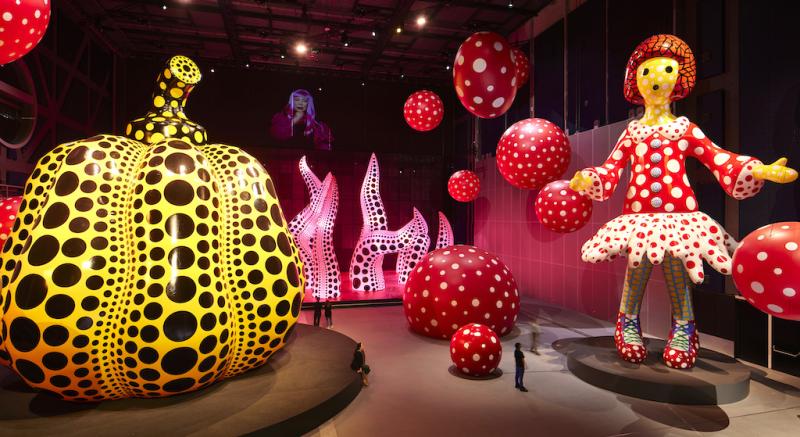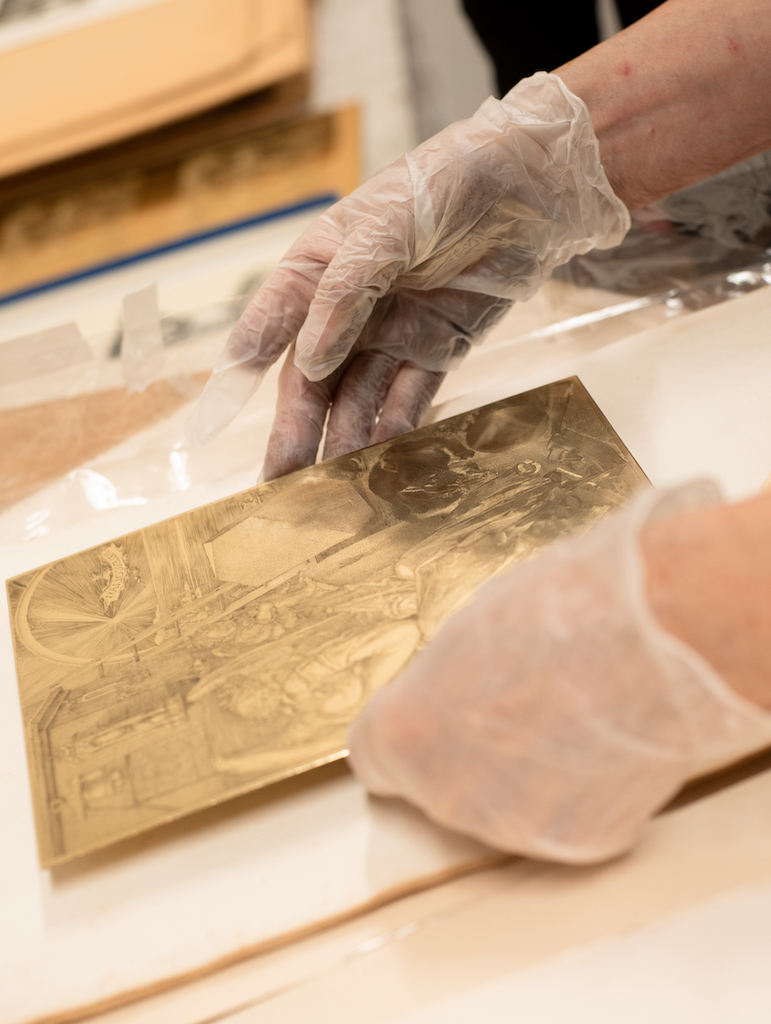Manchester International Festival exhibitions review - a new arts centre puts Manchester firmly on the cultural map | reviews, news & interviews
Manchester International Festival exhibitions review - a new arts centre puts Manchester firmly on the cultural map
Manchester International Festival exhibitions review - a new arts centre puts Manchester firmly on the cultural map
A host of giant inflatables, tricky balancing acts and a licence to print old master engravings - what's not to like?

At 94, Yayoi Kusama is said to be the world’s most popular living artist. People queue for hours to spend a few minutes inside one of her Infinity Rooms, spaces with walls mirrored to create infinite reflections.
Inviting her to inaugurate Manchester’s new Aviva Studios is an astute move, then. Her installation You, Me & The Balloons (main picture) is bound to attract crowds to the nearly finished venue built to house Factory International, organisers of the Manchester International Festival (MIF), and to host exhibitions, theatre and music gigs.
Reminiscent of Tate Modern’s Turbine Hall, the main space is a huge, 21 meter high hall with black walls that will be hard for any artist to occupy convincingly. Kusama has filled it with inflatable sculptures made over the past 30 years, some of which are 10 meters tall, yet even they are dwarfed by the cavernous environment.
 The Hope of the Polka Dots Buried in Infinity Will Eternally Cover the Universe, 2019 occupies a smaller anteroom, which gives the work focus and allows it to dominate. Hanging from the ceiling or snaking across the room before disappearing into the walls are dozens of fat yellow columns swarming with black polka dots. Soft, round and fleshy, the plastic tubes are as fascinating and as repellent as a nest of writhing serpents. A powerful smell of warming plastic fills the air which, along with the overpowering visuals, creates an experience so intense that it made me feel nauseous.
The Hope of the Polka Dots Buried in Infinity Will Eternally Cover the Universe, 2019 occupies a smaller anteroom, which gives the work focus and allows it to dominate. Hanging from the ceiling or snaking across the room before disappearing into the walls are dozens of fat yellow columns swarming with black polka dots. Soft, round and fleshy, the plastic tubes are as fascinating and as repellent as a nest of writhing serpents. A powerful smell of warming plastic fills the air which, along with the overpowering visuals, creates an experience so intense that it made me feel nauseous.
The main hall contains an enormous pumpkin, two giant girls and their dogs, a carpet of clouds resting on the floor (pictured above) and dozens of red spheres and gourd shaped inflatables hanging from the ceiling; but the impact of this heavenly host is diluted by the vast scale of the hangar-like interior and the low level lighting. The polka dots covering every sculpture still dazzle, though, while the whole ensemble is reflected in a large wall of mirrored fabric whose slight tremor causes the reflections to shimmer and produce an unnerving sense of instability.
Meanwhile on screen, Kusama sings the Song of a Manhattan Suicide Addict, 2007 in which she recounts in Japanese her battle with depression. The translation “Swallow antidepressants and it will be gone/ Tear down the gate of hallucinations…” is a stark reminder that the artist has experienced distressing hallucinations since she was a child. In the mid-1970s, after returning to Japan from a stint in New York, she committed herself, for her own safety, to a psychiatric hospital in Tokyo, where she still lives.
People tend to see Kusama's work as joyous, playful and festive, when actually it’s an expression of and an escape from her affliction. The apparent cheerfulness is like the smile painted on the face of a clown and, perhaps inadvertently, the MIF installation allows one to glimpse the anguish beneath the apparent gaiety.
 The installation climaxes on a more cheerful note, though. At the far end of the room is A Bouquet of Love I Saw in the Universe 2021 (pictured below). The pink columns are lit from within so an inviting glow emanates from each of these phallic personas. Standing on a pink platform resembling a dance floor, the prancing forms offer light hearted relief from the dizzying intensity of Kusama’s world.
The installation climaxes on a more cheerful note, though. At the far end of the room is A Bouquet of Love I Saw in the Universe 2021 (pictured below). The pink columns are lit from within so an inviting glow emanates from each of these phallic personas. Standing on a pink platform resembling a dance floor, the prancing forms offer light hearted relief from the dizzying intensity of Kusama’s world.
Meanwhile at the National Football Museum, fancy footwork and other skills are on display in a performance devised by artist Tino Sehgal and Manchester United footballer, Juan Mata. A squad of young people show off their balancing skills in a delightful series of moves. Sitting astride a stationary bicycle, a young woman miraculously keeps it upright while, beside her, another stands on one leg on tip toe and a reclining guy balances a football on his head. Cyclists do impossible wheelies, and a violinist plays her instrument lying down while duetting with a singer who also executes some cool moves. The various sequences are very laid back and absolutely charming.
At the Whitworth Economics the Blockbuster: It’s not Business as Usual consists of projects that “propose new ways of doing business”. Based in Lusanga, the Democratic Republic of Congo, CATPC (Cercle d’Art des Travailleurs des Plantation Congolaise) is an artist’s collective. With the profits they make from selling their sculptures abroad they buy back Unilever’s palm oil plantations, restore the decimated forests and grow food for the local community. When it comes to evaluating an artwork, key considerations are its authenticity and rarity. With Quantitative Melencolia 2022 (pictured above left) the Swedish duo Simon Goldin and Jakob Senneby throw a very disruptive spanner into the workings of the art market. Albrecht Dürer’s famous engraving Melencolia was printed in 1514 from a copper plate that has long since been lost. About 200 impressions are known to exist, one of which is owned by the Whitworth.
When it comes to evaluating an artwork, key considerations are its authenticity and rarity. With Quantitative Melencolia 2022 (pictured above left) the Swedish duo Simon Goldin and Jakob Senneby throw a very disruptive spanner into the workings of the art market. Albrecht Dürer’s famous engraving Melencolia was printed in 1514 from a copper plate that has long since been lost. About 200 impressions are known to exist, one of which is owned by the Whitworth.
Goldin+Senneby decided it was time to print some more. They scanned the Whitworth’s engraving and sent it to Sweden’s top bank note expert; from this high res image he was able to produce a facsimile of Dürer’s plate. On display are 18 impressions taken from the new plate and printed, like the originals, on sixteenth century paper sourced from a museum. Depending on the condition, a Dürer engraving costs anything from £85,000-£337,000; Quantitative Melencolia, on the other hand, would set you back £5,000 and it’s possible that Goldin+Senneby’s version will also become a collector’s item and accrue in value.
This is not the end of the story, though. On July 8th, visitors to the gallery will be able to watch a second edition being printed and will be able to buy a copy hot off the press. The criteria governing the art market are being well and truly scrambled!
- Yayoi Kusama You, Me & The Balloons at Aviva Studios until 28th August
- Tino Seghal’s “This Entry” at the National Football Museum until 5th July then at the Whitworth until 16th July
- “Economics the Blockbuster: It’s not Business as Usual” at the Whitworth until 22nd October
- More visual arts reviews on theartsdesk
rating
Explore topics
Share this article
The future of Arts Journalism
You can stop theartsdesk.com closing!
We urgently need financing to survive. Our fundraising drive has thus far raised £49,000 but we need to reach £100,000 or we will be forced to close. Please contribute here: https://gofund.me/c3f6033d
And if you can forward this information to anyone who might assist, we’d be grateful.

Subscribe to theartsdesk.com
Thank you for continuing to read our work on theartsdesk.com. For unlimited access to every article in its entirety, including our archive of more than 15,000 pieces, we're asking for £5 per month or £40 per year. We feel it's a very good deal, and hope you do too.
To take a subscription now simply click here.
And if you're looking for that extra gift for a friend or family member, why not treat them to a theartsdesk.com gift subscription?
more Visual arts
 'We are bowled over!' Thank you for your messages of love and support
Much-appreciated words of commendation from readers and the cultural community
'We are bowled over!' Thank you for your messages of love and support
Much-appreciated words of commendation from readers and the cultural community
 Photo Oxford 2025 review - photography all over the town
At last, a UK festival that takes photography seriously
Photo Oxford 2025 review - photography all over the town
At last, a UK festival that takes photography seriously
![SEX MONEY RACE RELIGION [2016] by Gilbert and George. Installation shot of Gilbert & George 21ST CENTURY PICTURES Hayward Gallery](https://theartsdesk.com/sites/default/files/styles/thumbnail/public/mastimages/Gilbert%20%26%20George_%2021ST%20CENTURY%20PICTURES.%20SEX%20MONEY%20RACE%20RELIGION%20%5B2016%5D.%20Photo_%20Mark%20Blower.%20Courtesy%20of%20the%20Gilbert%20%26%20George%20and%20the%20Hayward%20Gallery._0.jpg?itok=7tVsLyR-) Gilbert & George, 21st Century Pictures, Hayward Gallery review - brash, bright and not so beautiful
The couple's coloured photomontages shout louder than ever, causing sensory overload
Gilbert & George, 21st Century Pictures, Hayward Gallery review - brash, bright and not so beautiful
The couple's coloured photomontages shout louder than ever, causing sensory overload
 Lee Miller, Tate Britain review - an extraordinary career that remains an enigma
Fashion photographer, artist or war reporter; will the real Lee Miller please step forward?
Lee Miller, Tate Britain review - an extraordinary career that remains an enigma
Fashion photographer, artist or war reporter; will the real Lee Miller please step forward?
 Kerry James Marshall: The Histories, Royal Academy review - a triumphant celebration of blackness
Room after room of glorious paintings
Kerry James Marshall: The Histories, Royal Academy review - a triumphant celebration of blackness
Room after room of glorious paintings
 Folkestone Triennial 2025 - landscape, seascape, art lovers' escape
Locally rooted festival brings home many but not all global concerns
Folkestone Triennial 2025 - landscape, seascape, art lovers' escape
Locally rooted festival brings home many but not all global concerns
 Sir Brian Clarke (1953-2025) - a personal tribute
Remembering an artist with a gift for the transcendent
Sir Brian Clarke (1953-2025) - a personal tribute
Remembering an artist with a gift for the transcendent
 Emily Kam Kngwarray, Tate Modern review - glimpses of another world
Pictures that are an affirmation of belonging
Emily Kam Kngwarray, Tate Modern review - glimpses of another world
Pictures that are an affirmation of belonging
 Kiefer / Van Gogh, Royal Academy review - a pairing of opposites
Small scale intensity meets large scale melodrama
Kiefer / Van Gogh, Royal Academy review - a pairing of opposites
Small scale intensity meets large scale melodrama
 Jenny Saville: The Anatomy of Painting, National Portrait Gallery review - a protégé losing her way
A brilliant painter in search of a worthwhile subject
Jenny Saville: The Anatomy of Painting, National Portrait Gallery review - a protégé losing her way
A brilliant painter in search of a worthwhile subject
 Abstract Erotic, Courtauld Gallery review - sculpture that is sensuous, funny and subversive
Testing the boundaries of good taste, and winning
Abstract Erotic, Courtauld Gallery review - sculpture that is sensuous, funny and subversive
Testing the boundaries of good taste, and winning
 Edward Burra, Tate Britain review - watercolour made mainstream
Social satire with a nasty bite
Edward Burra, Tate Britain review - watercolour made mainstream
Social satire with a nasty bite

Add comment